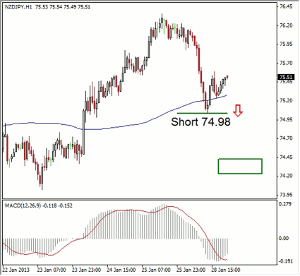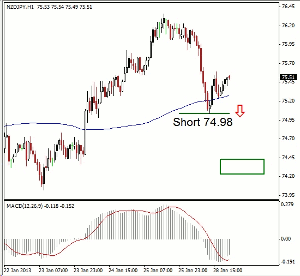In the good old days, the yen carry trade was all the rage, but as central banks all over the world slashed interest rates in the wake of the global financial crisis, it has fallen by the wayside, writes Mike Kulej of FXMadness.com, though he sees some interesting setups in other cross pairs.
Recent weakness in the Japanese yen revived discussion about the carry trade. While most of the decline in the JPY was a direct result of decisive moves in monetary policy in Japan, some claim that market participants are once more jumping into the carry trade. This means that the yen is the funding currency in order to purchase another currency paying higher interest rates. Perhaps it is true to some degree, but we should not expect to see the same level of participation in this activity as we did prior to the crisis of 2008.
There is a simple reason—interest rate differentials are much lower now, making the carry trade significantly less profitable. Among the developed economies only Australia and New Zealand offer rates that are even remotely promising. Still, at 3% and 2.5% respectively, they are nowhere near the 7% and 8%. In addition, central banks of these countries are under pressure to bring rates even lower, which will dampen effectiveness of the carry trade. At present, for this strategy to pay sizeable dividends, one would have to go long the Brazilian or Turkish currency, paying 7.25% and 5.5%. Unfortunately, neither one of them is very liquid and probably unnecessarily volatile. Besides, very few retail brokers offer them to trade, so this approach is not practical. The bottom line is that for all the talk about “return of the carry trade” at present it has very little impact on what is happening in the Japanese yen.
While on the subject of the Japanese yen, I am still looking for trades on the sell side, in all pairs. The EUR/JPY is suitable for very short-term transactions, while other crosses might be building setups with somewhat larger objectives. For example, the NZD/JPY could offer a short entry on the 1H chart, if the price dips under the support of 75.03. I plan to sell it at 74.98, aiming for 50-60 pips.
Another chart of interest is the EUR/CAD, especially the 1H graph. Here the price has settled into consolidation between 1.3528 and 1.3600. It is a relatively narrow range, unlikely to last for an extended period. I expect a directional move within next one-two days, although do not have a bias. The preceding price swing was strongly bullish, implying continuation. At the same time, however, chances for correcting are high, too. I am simply placing a straddle order looking for 50-60 pips in either direction.
By Mike Kulej of FXMadness.com




















